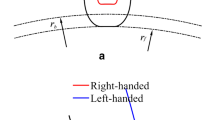Abstract
Despite helical broaching being an excellent method for internal helical ring gear manufacturing with regard to its machining efficiency and precision, the manufacture of this special helical broaching tool is a severe challenge because of its complex geometric structure like dual-spiral and step-feed pattern of cutting teeth as well as the tiny offset of its cutting edges, particularly considering the expensive tool cost and long manufacturing period. Aiming at finding an efficient and reliable machining method for this type of helical broaching tool, this paper developed a complete set of machining routes and corresponding paths to grind its cutting teeth. Through detailed investigation, the geometric structure of the helical broaching tool, the tooth index model, and two kinds of tooth coordinate calculating methods were proposed. The rough cutting section is suggested to be machined in four stages, while the length-varying reciprocating path and the single-tooth grinding path patterns are presented. Then, a special step-feed structure-driven grinding path pattern and three stages are developed to perform the manufacture of the finishing cutting section. Finally, the progressively truthful machined entities validate that the developed machining routes and three path patterns are practicable for helical broaching tool manufacturing and that they are effective in enhancing the machining efficiency and quality. In addition, the concise operations prove the friendly programmability of the grinding paths.
Similar content being viewed by others
References
Pu L, Ji M (2006) Design of machinery, 8th edn. Higher Education Press, Beijing
Ren X, Deng X, Su J, Wei B (2008) Study on the internal gear form grinding and wheel dressing technology. China Mech Eng 19:2647–2649
Guo E, Hong R, Huang X, Fang C (2015) Research on the cutting mechanism of cylindrical gear power skiving. Int J Adv Manuf Technol 79:541–550. doi:10.1007/s00170-015-6816-9
Savoy J, De Souza MM, Domingues TG, Sigoli PC (2013) Technical and economic advantages of cold forged planetary-bevel gears developed with net shape teeth and splines. SAE Technical Papers 13. doi:10.4271/2013-36-0551
Yuan Z, Liu H (2009) Metal cutting tool design manual: broach. China Machine Press, Beijing
Gonçalves DA, Schroeter RB (2015) Modeling and simulation of the geometry and forces associated with the helical broaching process. Int J Adv Manuf Technol 83:205–215. doi:10.1007/s00170-015-7578-0
Gonçalves DA, Paraski H, Schroeter RB (2009) Description of helical broach geometry using mathematical models associated with cad 3d models. 20th International Congress of Mechanical Engineering, Gramado, RS, Brazil.
Litvin FL, Fuentes A (2004) Gear geometry and applied theory, 2nd edn. Cambridge University Press, New York
Xiao D, Lee C (1994) A contact point method for the design of form cutters for helical gears. J Eng Ind 116:387–391
Hu Y, Tse W, Chen Y, Zhou Z (1998) Tool-path planning for roughing machining of a cavity by layer-shape analysis. Int J Adv Manuf Technol 14:321–329
Ren J, Yao C, Zhang D, Xue Y, Liang Y (2009) Research on tool path planning method of four-axis high-efficiency slot plunge milling for open blisk. Int J Adv Manuf Technol 45:101–109. doi:10.1007/s00170-009-2153-1
Chiou C-J, Lee Y (2002) A machining potential field approach to tool path generation for multi-axis sculptured surface machining. Comput Des 34:357–371. doi:10.1016/S0010-4485(01)00102-6
Ding S, Mannan MA, Poo AN, Yang D, Han Z (2003) Adaptive isoplanar tool path generation for machining of free-form surfaces. Comput Des 35:141–153. doi:10.1016/S0010-4485(02)00048-9
Lauwers B, Plakhotnik D (2012) Five-axis milling tool path generation with dynamic step-over calculation based on integrated material removal simulation. CIRP Ann Manuf Technol 61:139–142. doi:10.1016/j.cirp.2012.03.090
Wang N, Tang K (2008) Five-axis tool path generation for a flat-end tool based on isoconic partitioning. Comput Des 40:1067–1079. doi:10.1016/j.cad.2008.09.005
Makhanov SS (2009) Adaptable geometric patterns for five-axis machining: a survey. Int J Adv Manuf Technol 47:1167–1208. doi:10.1007/s00170-009-2244-z
Lavernhe S, Tournier C, Lartigue C (2007) Kinematical performance prediction in multi-axis machining for process planning optimization. Int J Adv Manuf Technol 37:534–544. doi:10.1007/s00170-007-1001-4
SINUMERIK 840D sl/828D Fundamentals programming manual. https://support.industry.siemens.com/cs/document/109476477/sinumerik-840d-sl-828d-fundamentals?dti=0&pnid=14594&lc=en-WW.
Author information
Authors and Affiliations
Corresponding author
Rights and permissions
About this article
Cite this article
Jia, K., Hong, J. & Fan, L. Grinding path planning for the cutting teeth of helical broaching tool. Int J Adv Manuf Technol 89, 87–100 (2017). https://doi.org/10.1007/s00170-016-9020-7
Received:
Accepted:
Published:
Issue Date:
DOI: https://doi.org/10.1007/s00170-016-9020-7




